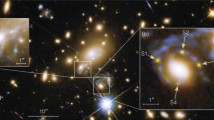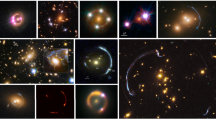Abstract
We discuss the prospects of gravitational lensing of gravitational waves (GWs) coming from core-collapse supernovae (CCSN). As the CCSN GW signal can only be detected from within our own Galaxy and the local group by current and upcoming ground-based GW detectors, we focus on microlensing. We introduce a new technique based on the analysis of the power spectrum and association of peaks of the power spectrum with the peaks of the amplification factor to identify lensed signals. We validate our method by applying it on the CCSN-like mock signals lensed by a point-mass lens. We find that lensed and unlensed signals can be differentiated using the association of peaks by more than one sigma for lens masses \(M_{\mathrm{L}} > 150\ M_{\odot }\). We also study the correlation integral between the power spectra and the corresponding amplification factor. This statistical approach can differentiate between unlensed and lensed signals for lenses as small as \(M_{\mathrm{L}} \sim 15\ M_{\odot }\). Further, we demonstrate that this method can be used to estimate the mass of a lens if the signal is lensed. The power spectrum-based analysis is general and can be applied to any broadband signal and is especially useful for incoherent signals.












Similar content being viewed by others
References
Abbott B. P., Abbott R., Abbott T. D., et al. 2019, Physical Review X, 9, 031040
Abbott R., Abbott T. D., Abraham S., et al. 2020, arXiv e-prints, arXiv:2010.14527
Abdikamalov E., Gossan S., DeMaio A. M., Ott C. D. 2014, Phys. Rev. D, 90, 044001
Adams S. M., Kochanek C. S., Beacom J. F., Vagins M. R., Stanek K. Z. 2013, ApJ, 778, 164
Afle C., Brown D. A. 2021, Phys. Rev. D, 103, 023005
Andresen H., Glas R., Janka H. T. 2021, MNRAS, 503, 3552
Andresen H., Müller B., Müller E., Janka H. T. 2017, MNRAS, 468, 2032
Andresen H., Müller E., Janka H. T., et al. 2019, MNRAS, 486, 2238
Bennett D. P. 2005, ApJ, 633, 906
Bozzetto L. M., Filipović M. D., Vukotić B., et al. 2017, ApJS, 230, 2
Broadhurst T., Diego J. M., Smoot George I. 2018, arXiv e-prints, arXiv:1802.05273
Cerdá-Durán P., DeBrye N., Aloy M. A., Font J. A., Obergaulinger M. 2013, ApJ, 779, L18
Christian P., Vitale S., Loeb A. 2018, Phys. Rev. D, 98, 103022
Diego J. M., Hannuksela O. A., Kelly P. L., et al. 2019, A&A, 627, A130
Dimmelmeier H., Ott C. D., Marek A., Janka H. T. 2008, Phys. Rev. D, 78, 064056
Edwards M. C. 2021, Phys. Rev. D, 103, 024025
Eker Z., Bakış V., Bilir S., et al. 2018, Monthly Notices of the Royal Astronomical Society, 479, 5491
Fryer C. L., Holz D. E., Hughes S. A. 2002, ApJ, 565, 430
Fryer C. L., New K. C. B. 2011, Living Reviews in Relativity, 14, 1
Haris K., Mehta A. K., Kumar S., Venumadhav T., Ajith P. 2018, arXiv e-prints, arXiv:1807.07062
Kuroda T., Takiwaki T., Kotake K. 2014, Phys. Rev. D, 89, 044011
Li S.-S., Mao S., Zhao Y., Lu Y. 2018, MNRAS, 476, 2220
Meena A. K., Bagla J. S. 2020, MNRAS, 492, 1127
Mishra A., Meena A. K., More A., Bose S., Singh Bagla J. 2021, arXiv e-prints, arXiv:2102.03946
Moniez M. 2010, General Relativity and Gravitation, 42, 2047
Morozova V., Radice D., Burrows A., Vartanyan D. 2018, ApJ, 861, 10
Mróz P., Udalski A., Skowron J., et al. 2019, ApJS, 244, 29
Mróz P., Udalski A., Szymański M. K., et al. 2020, ApJS, 249, 16
Müller B., Janka H.-T., Marek A. 2013, ApJ, 766, 43
Nakamura T. T., Deguchi S. 1999, Progress of Theoretical Physics Supplement, 133, 137
Ohanian H. C. 1974, International Journal of Theoretical Physics, 9, 425
Ott C. D., Burrows A., Dessart L., Livne E. 2006, Phys. Rev. Lett., 96, 201102
Ott C. D. 2009, Classical and Quantum Gravity, 26, 063001
Ott C. D., Abdikamalov E., Mösta P., et al. 2013, ApJ, 768, 115
Peters P. C. 1974, Phys. Rev. D, 9, 2207
Piro A. L., Pfahl E. 2007, ApJ, 658, 1173
Powell J., Gossan S. E., Logue J., Heng I. S. 2016, Phys. Rev. D, 94, 123012
Powell J., Müller B. 2020, MNRAS, 494, 4665
Radice D., Morozova V., Burrows A., Vartanyan D., Nagakura H. 2019, ApJ, 876, L9
Savitzky A., Golay M. J. E. 1964, Analytical Chemistry, 36, 1627
Scheidegger S., Fischer T., Whitehouse S. C., Liebendörfer M. 2008, A&A, 490, 231
Scheidegger S., Whitehouse S. C., Käppeli R., Liebendörfer M. 2010, Classical and Quantum Gravity, 27, 114101
Schneider P., Ehlers J., Falco E. E. 1992, Gravitational Lenses, https://doi.org/10.1007/978-3-662-03758-4
Somiya K. 2012, Classical and Quantum Gravity, 29, 124007
Sotani H., Takiwaki T., Togashi H. 2021, arXiv e-prints, arXiv:2110.03131
Suyama T., Takahashi R., Michikoshi S. 2005, Physical Review D, 72, https://doi.org/10.1103/physrevd.72.043001
Takahashi R., Nakamura T. 2003, ApJ, 595, 1039
Unnikrishnan C. S. 2013, International Journal of Modern Physics D, 22, 1341010
Vartanyan D., Burrows A. 2020, ApJ, 901, 108
Vink J. 2020, Physics and Evolution of Supernova Remnants (Springer)
Warren M. L., Couch S. M., O’Connor E. P., Morozova V. 2020, ApJ, 898, 139
Wyrzykowski L., Skowron J., Kozłowski S., et al. 2011, MNRAS, 416, 2949
Xu F., Ezquiaga J. M., Holz D. E. 2021, arXiv e-prints, arXiv:2105.14390
Yakunin K. N., Mezzacappa A., Marronetti P., et al. 2015, Phys. Rev. D, 92, 084040
Acknowledgments
The authors would like to thank Ambresh Shivaji for helpful discussions and comments. RR thanks the Department of Science and Technology, Government of India for being awarded the INSPIRE scholarship. AKM would like to thank the Council of Scientific and Industrial Research (CSIR), India for financial support through research fellowship No. 524007. The authors thank the anonymous referee for insightful comments. The authors acknowledge the use of the IISER Mohali HPC facility. This research has made use of NASA’s Astrophysics Data System Bibliographic Services.
Author information
Authors and Affiliations
Corresponding author
Appendix: How good is the point-mass approximation?
Appendix: How good is the point-mass approximation?
A straightforward generalization to the point-mass approximation is to model the microlens as a uniform-density sphere of radius \(R_\star\). The corresponding three-dimensional gravitational potential is given as
and the corresponding projected gravitational lensing potential is given as (Suyama et al. 2005)
where \(R =R_\star / \xi _0\) is the radius of the lens normalized by the Einstein radius \(( {=}\sqrt{4 G M_{\mathrm{L}} D_{\mathrm{d}} D_\mathrm{ds} / c^2 D_{\mathrm{s}}})\) of the lens system. It turns out that this (dimensionless) parameter R is what determines the accuracy of the point-mass approximation.
In Figure 12, we show the absolute and phase values of the amplification factor for a point-mass lens and uniform density sphere lenses. When the radius of the lens is \(R\sim 0.1\) (or even smaller), the point-mass lens approximation leads to very accurate results. However, as the radius increases (\(R\sim 0.4\)–0.5), we begin to notice discrepancies between the two models at high frequency values. For even larger values of lens radius, the point-mass lens approximation no longer holds.
To assess the physical situations during which the point-mass approximation holds, we next provide certain ballpark numbers for the value of R:
-
1.
For a lens system in which all distances are of the order of one kpc, and for a solar mass lens, the Einstein radius is of the order of \(10^{-9}\) rad. The angular size of the Sun at this distance is \({\sim } 10^{-11}\) rad, and thus \(R {\sim } 0.01\). Hence, for typical galactic distances, a solar mass lens is well approximated by a point-mass lens.
-
2.
For stars on the main sequence, \(R_\star \propto M^{0.57}\) (Eker et al. 2018), while the Einstein radius \(\propto M^{0.5}\). Thus, \(R \propto M^{0.07}\). The value of R remains fairly constant with increase in mass, and hence the point-mass lens approximation holds true for even larger stars within typical galactic distances.
-
3.
When all relevant distances are of order D, the Einstein radius \({\propto } \sqrt{D}\), while the angular size of an object \({\propto }\, D^{-1}\), and hence \(R \propto {1}/{\sqrt{D}}\). At large values of D (>1 kpc), the value of R is bound to decrease. However, for values of \(D < 1\) kpc, the value of R will begin to increase and if D happens to be a few tens of parsecs, R will be of order unity. It is only in this unlikely scenario that the point-mass approximation ceases to hold.
Given that the uniform sphere model is a highly simplified and unrealistic model, one may try to use an alternate mass distribution profile. One possibility is that of a polytrope of index \(n=3\), but as has been shown in Ohanian (1974), the difference is again noticeable only when R is of order unity.
Rights and permissions
About this article
Cite this article
Ramesh, R., Meena, A.K. & Bagla, J.S. Gravitational lensing of core-collapse supernova gravitational wave signals. J Astrophys Astron 43, 5 (2022). https://doi.org/10.1007/s12036-021-09787-3
Received:
Accepted:
Published:
DOI: https://doi.org/10.1007/s12036-021-09787-3




